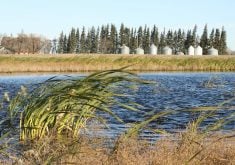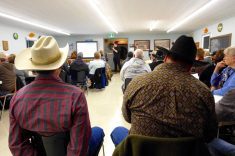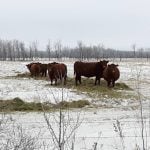We hear about neospora from time to time. It’s a protozoal parasite similar to coccidiosis, cryptosporidiosis or toxoplasmosis.
Many years ago it was diagnosed in dairy cows that were aborting, and it should always be considered if a producer sees abortions. It is spread through canine species — dogs, coyotes, foxes and wolves — but the real problem comes when it completes its life cycle in cattle.
There is no treatment to prevent the resulting abortions. Years ago, for a short while, there was a vaccine in cattle but due to low use and marginal benefits, it was discontinued. I read one study where abortions were reduced in an infected herd with vaccination but early embryonic death went up. So, the vaccine appeared helpful in one way and detrimental in another.
Read Also

Beekeepers want financial protection against tropi mite
What happens to beekeepers if the deadly tropi mite reaches Canada? Discover why farmers want robust compensation to protect pollination.
I’ve been asked whether cows that have previously aborted due to neospora are now immune. The answer is maybe, but in reality a cow that aborts is generally culled, so there’s not a lot of data to support that claim.
Only in rare cases, when the pregnancy aborts near full term, will a dairy cow begin to produce milk and be kept.
If a producer or veterinarian suspects an abortion has occurred, neospora is one of the things checked. If it is found, the most important management consideration is finding out how it is being transmitted into cattle.
The spreading mechanism is fecal to oral, from canines to cattle. Farm dogs are often the primary suspect, but it could also be coyotes defecating in feed bunks or feed rooms. It can even come from grazing.
With dogs or canines of any type, the infection is generally subclinical and can only be diagnosed by seeing the oocysts (eggs) in the feces, similar to coccidiosis.
An English dairy producer recently told me they’re seeing a problem with transmission due to public walking trails that pass through private land. Dogs are defecating in pastures and passing neospora and other infections to cattle.
He noted producers are beginning to believe they will need to lobby to have dogs checked for disease before they’re allowed on these walking trails.
I have always said if there’s too much interaction, it can cause an issue. Sheep and goats can also be affected with the same transmission mechanism.
With protozoal infections, the sulfonamide antibiotics are the only ones somewhat successful. However, they seem ineffective in cattle but do help clear dogs of the infection.
The infection does not spread cattle to cattle, but does transmit through the placenta to the unborn fetus. The cow then either aborts or the calf is born with the infection. There will be increased incidence in more populated areas and where dogs or other canines can get into feed areas, feed bunks or areas where the cattle graze.
If the canines, as carnivores, can ingest the aborted fetuses or predate cattle, sheep, goats, etc., that harbour the immature stages of the parasite, it completes the life cycle.
Another challenge is that the coccidian-like oocysts are quite resistant to disinfectants and can survive for a long time, even over winter.
This protozoa was only discovered in about the mid 1980s, after I graduated from veterinary school, and isn’t well understood. It pops up here and there in Canada, mainly in dairy cattle more than beef, but we need to watch for abortion storms.
It is more common in more temperate climates like the U.S. or England because freezing can give some break in the life cycle.
I have not seen much of it mentioned in wildlife, and many other parasitic diseases are studied in our coyotes, so hopefully it is of low incidence in them. We all know coyotes and wolves have encounters with cattle and definitely scavenge dead animals, take placentas and consume other available sources of animal protein.
As time goes on and if this disease increases in incidence, more research may examine whether immunity is established after infection, vaccination in cattle, and surveillance for it in farm dog or coyote populations.
The drug toltrazuril is really effective against coccidiosis. Could it work against early cases of neospora? There has been some talk of potential resistance occurring with coccidian and toltrazuril (trade name Baycox) but I have not seen any hard evidence.
With the use of rumensin in most rations and the use of deccox in creep feed, I have heard of few cases of coccidiosis in many years. Coccidia is a great example of a parasitic disease where we know the life cycle and can work on countermeasures. Increasing biosecurity and preventation, as well as treatment and isolation when necessary, can reduce the incidence considerably.
In Canada, winter affects transmission. Coccidiosis and neospora are two examples where global warming could bring a higher incidence here.
Listen for updated information and research on neospora in the years to come. If you encounter these types of disease, reach out to other producers. Your veterinarian can contact other veterinarians and perhaps implement more specific preventive measures .
If possible, please share information on outbreaks with industry groups, including the Canadian Cattle Association or Beef Cattle Research Council so many can benefit from your experience.
















